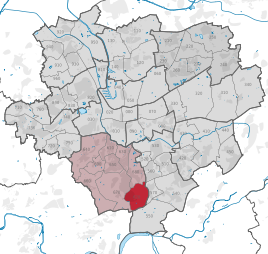Bitter pulp
|
Bitter pulp
City of Dortmund
Coordinates: 51 ° 26 ′ 48 ″ N , 7 ° 27 ′ 52 ″ E
|
|
|---|---|
| Height : | 199 m above sea level NHN |
| Area : | 3.63 km² |
| Residents : | 2692 (Dec. 31, 2019) |
| Population density : | 743 inhabitants / km² |
| Incorporation : | August 1, 1929 |
| Postcodes : | 44227, 44229 |
| Area code : | 0231 |
| Statistical District : | 62 |
|
Location of Bittermark in Dortmund
|
|
Bittermark is the statistical district 62 and at the same time a southern part of the city of Dortmund . It is located in the district of Hombruch , has an area of 363 hectares and has around 2700 inhabitants. The residential development of the Bittermark is primarily characterized by single-family houses and a low settlement density. The forest near Bittermark is considered an upscale residential area with corresponding real estate and land prices. The federal motorway 45 runs through the district .
history
For centuries, the Bittermark was a pure forest area on the northern slopes of the Ardey Mountains . The first settlement began after 1770 through clearing and the construction of isolated cottages . The Bittermark area was administered by the parish of Kirchhörde .
Part of the Wellinghofen office in the Hörde district , the Bittermark fell in 1925 as part of the incorporation into the city of Dortmund.
Industrialization moved into Bittermark with the opening of the Gottessegen mine . Today the colliery is reminiscent of a workshop for the disabled with the same name and the colliery's former extinguishing water ponds .
Towards the end of the Second World War, crimes at the end of the war were committed in the city forest of Bittermark . At Easter 1945, from March 7th to April 12th, around 300 people were murdered by the Gestapo in a clearing in the Bittermark, in Rombergpark and on the railway site between Hörde and Berghofen . The Bittermark memorial has been a reminder of the crimes since 1960 . Every year on Good Friday there is a memorial service in honor of the victims.
population
On December 31, 2019, there were 2,692 residents in Bittermark.
Structure of the bitter marker population:
- Share of the population under 18-year-olds: 13.3% [Dortmund average: 16.2% (2018)]
- Population share of at least 65-year-olds: 25.4% [Dortmund average: 20.2% (2018)]
- Proportion of foreigners: 5.2% [Dortmund average: 18.8% (2019)]
- Unemployment rate: 4.1% [Dortmund average: 11.0% (2017)]
The average income in Bittermark is around 85% above the Dortmund average.
Population development
| year | Pop. |
|---|---|
| 1987 | 2297 |
| 2003 | 2518 |
| 2008 | 2563 |
| 2010 | 2581 |
| 2013 | 2639 |
| 2016 | 2711 |
| 2018 | 2706 |
Web links
Individual evidence
- ↑ Population figures in the statistical districts on December 31, 2019 (PDF)
- ↑ Jan Niko Kirschbaum: memorials as signs of time. National Socialism in the culture of remembrance in North Rhine-Westphalia . transcript, Bielefeld 2020, ISBN 978-3-8376-5064-8 , pp. 156-184.
- ↑ Population share of the under 18 year olds Statistical Atlas 2019 (PDF file)
- ↑ Population share of at least 65-year-olds Statistical Atlas 2019 (PDF file)
- ↑ Nationalities in the statistical districts on December 31, 2019 (PDF file)
- ↑ Unemployment rates according to statistical districts on June 30, 2017 ( memento of the original from June 25, 2018 in the Internet Archive ) Info: The archive link was inserted automatically and has not yet been checked. Please check the original and archive link according to the instructions and then remove this notice. (PDF file)



